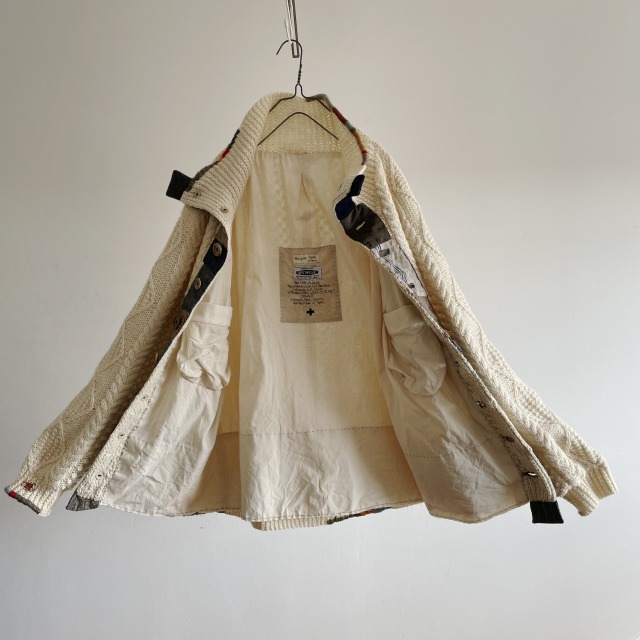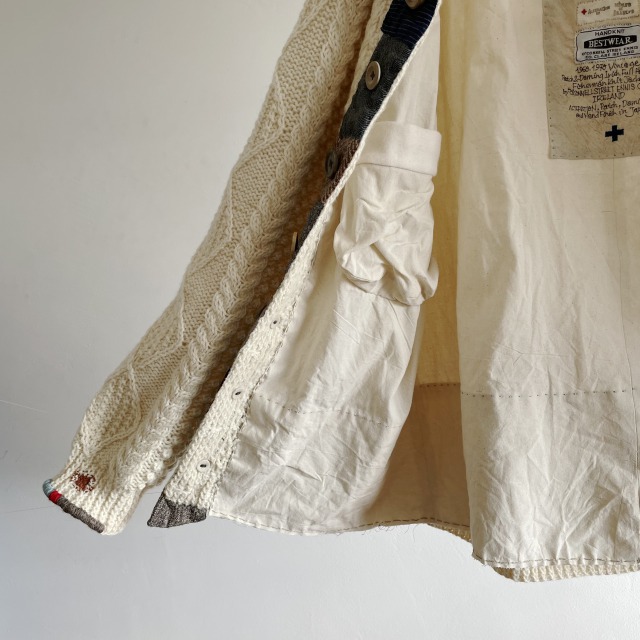SOLD
1960-1970 Vintage Patch & Darning Irish Full Hand-knit Fisherman Knit Jacket by “O’CONNELL Street Ennis CO> Clare” Ireland
アイルランド北西部のアラン諸島発祥のアランセーター、英仏海峡チャンネル諸島のガーンジー島あたりのガーンジーセーター、北欧のノルディックセーター、アイスランドのロピーセーターなど、海に出て船の上でさまざまな作業を行う必要のある漁師が発祥とされるセーターが北部ヨーロッパにはいくつもあります。
The Aran sweater originated in the Aran Islands in northwestern Ireland, the Guernsey sweater around the island of Guernsey in the Channel Islands, the Nordic sweater in Scandinavia, and the Lopi sweater in Iceland. There are a number of sweaters in northern Europe that originated with fishermen who needed to go out to sea to perform various tasks on their boats.


暖流の北大西洋海流のおかげで、かなりの高緯度地帯でありながら海が凍ることはないとはいえ、英国北部やアイルランド、スカンジナビアは寒冷で霧の多い厳しい気候の荒涼とした風景が続きます。産業は農業を産業にできるだけの収穫を阻む痩せた土壌でも生える草でも飼育が可能な牧羊と、周りを取り囲む海での漁業だけが主な産業でした。
Even though the warm North Atlantic Current keeps the seas from freezing even at fairly high latitudes, northern Britain, Ireland and Scandinavia are still desolate landscapes with a cold, foggy and harsh climate. The only industries were sheep farming, which could be raised on grass that could grow even in the thin soil that prevented harvesting enough to make agriculture an industry, and fishing in the sea that surrounded the area.


これらの地域に暮らす普通の人々が身に着ける物で自給出来たのは、この気候のなかでも育てられた亜麻(リネン)や麻(ヘンプ)と、羊の毛を利用した織物だけでした。真夏でも最高気温が17度程度という寒冷な気候では、1年を通して羊毛で作った衣服は欠かせないもので、着るものを自給するために家々がそれぞれ羊毛から糸を紡ぎ、自分達で着る物にする技術と伝統を育むことは自然な事でした。
The only materials that ordinary people in these areas could produce for themselves were linen and hemp, which could be grown in this climate, and textiles made from sheep’s wool. In this cold climate, where the maximum temperature is only about 17 degrees Celsius even in mid-summer, woolen clothes are essential throughout the year. It was natural for each family to develop the skills and traditions to spin wool into yarn and make their own clothes in order to be self-sufficient.


特にこの辺り沿岸部の唯一と言える産業の従事者である漁師達にとっては、厳しい海の自然条件から身を守るための仕事着が必要でした。水を弾き浸透させない為にも羊の毛の油分をあまり脱いていない原毛を使い、暖かさを保ちつつ、嵩張らず着脱が簡単で、お金をかけずに(家で作れる)手に入る防寒着が、自分たちの手で編んだ手編みのセーターでした。
Especially for the fishermen, who are the only industrial workers in this coastal area, they needed work clothes to protect themselves from the harsh natural conditions of the sea. Hand-knitted sweaters were made from raw sheep’s wool that had not lost much of its oil content in order to repel water and prevent it from penetrating the wool, and were warm, not bulky, easy to put on and take off, and inexpensive to make (at home).


フィッシャーマンセーターの代表格として位置づけられているアランセーターはアイルランドのアラン諸島で6世紀頃に誕生したといわれていますが、実際は一人の編み物の天才女性が、1900年代初め頃にアラン島の港に出入りしていたスコットランド人家族の着ていたガーンジーセーターからヒントを得て作り出したものがはじまりです。元々ガーンジーセーターと同じように汚れの目立たないネイビーで編まれていましたが、教会で堅信礼を迎える息子の晴着としてその女性は白いセーターを編みました。
The Aran sweater, which is regarded as a representative of the fisherman’s sweater, is said to have originated around the 6th century in the Aran Islands of Ireland, but in reality, it was created by a woman who was a knitting genius and was inspired by a Guernsey sweater worn by a Scottish family that frequented the port of Aran in the early 1900s. Originally, it was knitted in navy, the same color as the Guernsey sweater, but the woman knitted a white sweater for her son to wear for his Confirmation at church.


そのセーターは島の女性達の多くに模倣され、それぞれによって様々な編み地も考案され、やがて島の教会行事での子供達の正装となり定着しました。1930年代にアイルランド本島から島にやってきた女性がその白いセーターを見つけ、首都ダブリンの自分の店で販売。さらに、それを目にしたある服飾評論家が「アラン諸島では世界のどこにも見られないセーターが編まれている。見事に装飾的な編み柄が施された白いセーターで、これは6世紀にこの島へ渡った聖人エンダによってもたらされたものである」という自分で作り上げた物語とともに英国に紹介し、さらにスコットランドで模倣品を作らせて英国での販売を始めました。
The sweaters were imitated by many of the women on the island, and different knitting techniques were devised for each, and eventually they became the formal dress for children at church functions on the island. In the 1930s, a woman from Ireland found the white sweater and sold it in her shop in Dublin, the capital of Ireland. In addition, a clothing critic who saw them introduced them to Britain with a story of his own making: He introduced it to England with a story he made up: “In the Aran Islands there is a sweater knitted like nowhere else in the world, a white sweater with a wonderfully decorative pattern, which was brought to the islands by the saint Enda in the sixth century. He had imitations made in Scotland and began selling them in England.


そうして作り上げられたアランセーターの伝説は世界中に流布され定着して行きました。第二次対戦後、英国からの独立を果たしたばかりで貧しかったアイルランドにとって、アランセーターは魅力的な輸出品となる要素を持つため、さらに伝説を上書きし、家庭用の個人制作から家内制手工業レベルの生産体を整え発展させ、アイルランド系移民の子孫だったJ.F.ケネディ時代のアメリカ60年代に大ブームに至りました。
The legend of the Aran sweater then spread around the world and took root. After the Second World War, when Ireland was poor and had just gained independence from Britain, the Aran sweater became an attractive export item, and the legend was overwritten further. This led to a huge boom in the 1960s in the United States during the era of J.F. Kennedy, a descendant of Irish immigrants.


このセーターの6世紀や15世紀という発祥は作られた伝説ですが、100年以上アラン諸島の女性達に受け継がれ編みつがれている(漁師の家族用も少し含みますが殆どは販売のため)歴史は事実ですし、その毛糸の風合いや、編むのに10日以上もかかってしまう手編みの味わいは本物です。しかし今ではアラン諸島に住む編み手は20人程度となり、島内かアイルランド国内での販売が精一杯で、輸出するほどの量も作られず、アラン諸島産の純粋なアランセーターの歴史は閉じられようとしています。
The origin of this sweater in the 6th or 15th century is a legend made up, but the history of this sweater, which has been handed down and knitted by the women of the Aran Islands for over 100 years (including a few for the fishermen’s families, but mostly for sale), is a fact, and the texture of the yarn and the taste of the hand-knitting process, which can take more than 10 days to complete, is authentic. But nowadays, the Aran Islands are the only place in the world where you can find them. However, there are now only about 20 knitters living in the Aran Islands, and they can only sell their products on the islands or in Ireland, not enough to export.


この1枚も、アイルランドがアランセーターの輸出に国を挙げて取り組んでいた1960年代に編まれたフルハンドニットのもの。タグにはブランドではなく、作られた街や通りの名前の“O’CONNELL Street Ennis CO. Clare”が誇らしげに掲げられています。Ennis はエリザベス1世支配下の時代にアイルランド西部の首都となり、その後数世紀にわたって、マーケットタウンとして製造と流通の中心地としてアラン諸島を含むアイルランド西部のハブとなっていた街です。
This fully hand-knit knit jacket was knitted in the 1960s, when Ireland was making a national effort to export Aran sweaters. The tag proudly displays not the brand name, but the name of the town or street where it was made, “O’CONNELL Street Ennis CO.Clare”. Ennis was the capital of the west of Ireland during the reign of Elizabeth I, and for centuries afterwards it was the hub of the west of Ireland, including the Aran Islands, as a market town and manufacturing and distribution center.


この1枚は、アイルランド国内に住むアイルランド人の編み手が全部を一人で編んだ、純然たる「メイド・イン・アイルランドのアラン柄のハンドニット」で、今では新たに作られる事の少ないものです。様々な編み地を組み合わせたこのセーターは、熟練した編み手でも10日以上もかかってしまう複雑なもの。一番ポピュラーなオフホワイト(生成り)色は、現地ではゲール語で「そのまま」を意味するBainin(バイニン)と表されます。
This one is a pure “Made in Ireland Aran Pattern Hand Knit”, knitted entirely by one Irish knitter living in Ireland, and is rarely made anew nowadays. This sweater is a combination of various knitted fabrics, and is complex enough to take even a skilled knitter more than 10 days to make. The most popular color, off-white (raw), is locally called Bainin, which means “as is” in Gaelic.


アランセーターを定義すると、1、アラン諸島の編み手によって全部一人で編まれたもの。2、アラン諸島とその周辺のアイルランド西岸地方の編み手によって全部一人で編まれたもの。3、アイルランド国内に住むアイルランド人の編み手が全部一人で編んだもの。までがアランセーターだと思われます。4、英国(スコットランド)など、アイルランド以外の欧州地域で編まれたもの(日本で評価の高いインバーアラン(Inverallan)はスコットランドで編まれた上質なアラン柄の手編みセーターですが、アランセーターではありません)や、中国やインドなど編まれたもの、機械編みのものは単なるアラン柄編みのセーターと考えるべきかもしれません。このジャケットは2に該当します。
Aran sweaters can be defined as: 1. knitted entirely by one person in the Aran Islands; 2. knitted entirely by one person in the Aran Islands and the surrounding west coast of Ireland; 3. knitted entirely by one person by an Irish knitter living in Ireland; 4. 3. knitted entirely by Irish knitters living in Ireland; 4. knitted in European countries other than Ireland, such as England (Scotland) (Inverallan, which is highly regarded in Japan, is a fine hand-knitted sweater with an aran pattern knitted in Scotland, but it is not an aran sweater); 5.Chinese, Indian and other knitted or machine-knitted sweaters may be considered as just aran pattern knitted sweaters. This jacket falls into category 2.


このような背景の中で作られた、1960年台アイルランド産の手編みのアラン柄のフィッシャーマンズニットの襟付きカーディガンをALTERATIONしたジャケットです。
This jacket is an ALTERATION of an Aran pattern a 1960’s Irish hand-knit fisherman’s knit cardigan with a collar.


アウターとしての防寒性やポケットなどの機能、着やすさを高めるために内側につけたライニング。ラスティックなコットンブロードは、適度な張りとシワ感が有り、インドで織られた素朴な糸の表情が魅力です。
The lining is attached on the inside to enhance the warmth, pockets and other functions as outerwear, and ease of wear. The rustic cotton broadcloth has a moderate tension and wrinkles, and the rustic look of the yarn woven in India is attractive.


ジャケットとしての機能を高める丸いフォルムと膨らみが味のある内ポケット。味わいと清潔感を与えるコントラスト。
The round shape and bulging inner pockets that enhance the function of the jacket. The contrast gives a sense of taste and cleanliness.


ライニングを留め付けたvintageのリネンコード。手仕事ゆえのステッチの意図せぬ自然な乱れが生むリズム。
Vintage linen cord fastening the lining. The rhythm created by the unintentional and natural disorder of the stitching due to the handwork.


ニットの伸び縮みする良さと、柔らかさを邪魔しないために、ライニングの裾はとめずに浮かせた状態。そのライニングのカットされたヘムで遊ぶ糸が、印象を軽やかに。
In order not to interfere with the elasticity and softness of the knit, the hem of the lining is left floating. The yarn that plays with the cut hem of the lining gives a light impression.


裾や袖口の糸切れには、アクセントを兼ねたwrap around stitchを。
Wrap around stitching is used to accentuate thread breaks at the hem and cuffs.


長年の着用による引っ掛けや糸切れダメージを補修したdarning。
The darning has been repaired from thread breakage damage caused by snagging over years of wear.


両方の前たてには、アクセントと補修を兼ねてvintageやantiqueの端切れをpatch。ボタンはランダムに選んだvintageのウッドボタン。
Both fronts are patched with vintage or antique scraps for accent and repair. The buttons are randomly selected vintage wood buttons.


大きめの襟はボタンを付けて、立てて留められるように。へムのpatchは端から飛び出して伸びる形もユニークです。手編みならではの継ぎ目のないポケットは、あえて解体せずにコットンの内袋を付けて使いやすいポケットに。
The large collar is buttoned so that it can be fastened standing up. The patch on the hem is also unique in that it pops out from the edge and extends. The seamless pockets, which are unique to hand-knitting, are not dismantled, but instead a cotton inner bag is attached to make them easy to use.


ベーシックでありながらどこかモダンな佇まい。
そんな、古いだけ、新しいだけでは、出来ないことができる服。
Basic, yet somehow modern in appearance.
This is the kind of clothing that can’t be done with just anything old or new.


サイズ 2
裄丈(ラグランスリーブ) =90cm :(肩幅50cm袖丈60cm相当)
バスト=58cm(脇下)
着丈 =71cm
アイルランド/日本製
表地 = Irish Unbleached Wool / Wool100%
ライナー = Indian Rustic Cotton Broad Cloth / Cotton 100%
ボタン = Vintage Wood Button (Random Choice)
& Antique Fabric Covered Button
STOREへのリンク
[ALTERATIy Manure of Drawers] SOLD

